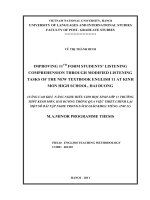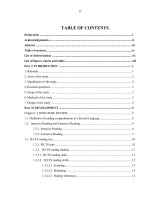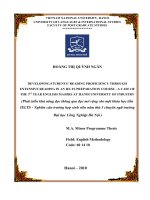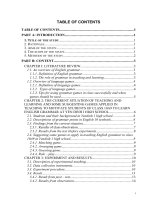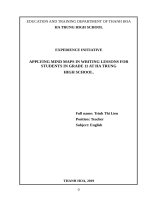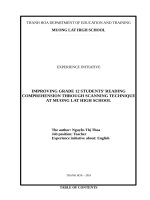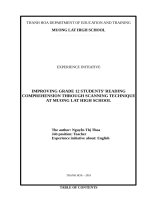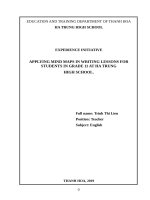Improving 11th form students' listening comprehension through modified listening task of the new textbook English 11 at Kinh Mon High school Nâng cao khả năng
Bạn đang xem bản rút gọn của tài liệu. Xem và tải ngay bản đầy đủ của tài liệu tại đây (1.75 MB, 60 trang )
VIETNAM NATIONAL UNIVERSITY, HANOI
UNIVERSITY OF LANGUAGES AND INTERNATIONAL STUDIES
FACULTY OF POST- GRADUATE STUDIES
*********************
VŨ THỊ THÀNH DINH
IMPROVING 11
TH
FORM STUDENTS’ LISTENING
COMPREHENSION THROUGH MODIFIED LISTENING
TASKS OF THE NEW TEXTBOOK ENGLISH 11 AT KINH
MON HIGH SCHOOL, HAI DUONG
(NÂNG CAO KHẢ NĂNG NGHE HIỂU CHO HỌC SINH LỚP 11 TRƯỜNG
THPT KINH MÔN, HẢI DƯƠNG THÔNG QUA VIỆC THIẾT CHỈNH LẠI
MỘT SỐ BÀI TẬP NGHE TRONG SÁCH GIÁO KHOA TIẾNG ANH 11)
M.A.MINOR PROGRAMME THESIS
FIELD: ENGLISH TEACHING METHODOLOGY
CODE : 601410
HANOI – 2011
VIETNAM NATIONAL UNIVERSITY, HANOI
UNIVERSITY OF LANGUAGES AND INTERNATIONAL STUDIES
FACULTY OF POST- GRADUATE STUDIES
*********************
VŨ THỊ THÀNH DINH
IMPROVING 11
TH
FORM STUDENTS’ LISTENING
COMPREHENSION THROUGH MODIFIED LISTENING
TASKS OF THE NEW TEXTBOOK ENGLISH 11 AT KINH
MON HIGH SCHOOL, HAI DUONG
(NÂNG CAO KHẢ NĂNG NGHE HIỂU CHO HỌC SINH LỚP 11 TRƯỜNG
THPT KINH MÔN, HẢI DƯƠNG THÔNG QUA VIỆC THIẾT CHỈNH LẠI
MỘT SỐ BÀI TẬP NGHE TRONG SÁCH GIÁO KHOA TIẾNG ANH 11)
M.A.MINOR PROGRAMME THESIS
FIELD: ENGLISH TEACHING METHODOLOGY
CODE : 601410
SUPERVISOR: NGUYỄN THỤY PHƯƠNG LAN, M.A.
HANOI - 2011
iv
TABLE OF CONTENTS
Candidate’s statement i
Acknowledgements ii
Abstract iii
List of tables and charts viii
List of abbreviations ix
page
PART I: INTRODUCTION
1
1. Rationale…………………………………………………………………
1
2. Aims of the study…………………………………………………………
2
3. Research questions………………………………………………………
2
4. Scope of the study…………………………………………………………
2
5. Design of the study………………………………………………………
2
PART II: DEVELOPMENT
3
CHAPTER ONE: LITERATURE REVIEW
3
1.1. Theoretical background of listening skill……………………………………………
3
1.1.1. Definitions of listening………………………………………………………
3
1.1.2. Definitions of listening comprehension……………………………………
3
1.1.3. The significance of listening comprehension……………………………….
4
1.1.4. Factors affect students’ listening comprehension……………………………
5
1.2. Listening tasks………………………………………………………………….
6
1.2.1. Definitions of task …………………………………………………………
6
1.2.2. Criteria of a good listening task…………………………………………….
6
1.2.3. Types of listening tasks…………………………………………………….
7
1.3. Material adaptation………………………………………………………………
9
v
1.3.1. Definition of material adaptation………………………………………….
9
1.3.2. Reasons for adapting materials……………………………………………
10
1.3.3. Principles for adapting materials………………………………………….
11
1.3.4. Techniques for adapting materials………………………………………
11
1.3.5. Levels of material adaptation…………………………………………….
12
1.3.5.1. Macro adaptation…………………………………………………………
12
1.3.5.2. Adapting a unit………………………………………………………….
13
1.3.5.3. Adaptation of specific activities………………………………………
13
CHAPTER TWO: THE METHODOLOGY
14
2.1. Research method of the study…………………………………………………………
14
2.1.1. An overview of action research……………………………………………
14
2.1.2. Action research models………………………………………………………
14
2.1.3. Action research cycle and procedure for this research………………………
15
2.2. Data collection instruments…………………………………………………………
17
2.2.1. Pre and post tests…………………………………………………………….
17
2.2.2. Survey questionnaires………………………………………………………
18
2.2.3. Classroom observations……………………………………………………
19
2.2.4. Teaching diary………………………………………………………………
19
2.2.5. Textbook analysis……………………………………………………………
20
2.3. Participants………………………………………………………………………………
20
2.3.1. The teacher/ researcher……………………………………………………….
20
2.3.2. The non- participate observer………………………………………………
20
2.3.3. The students………………………………………………………………….
20
2.4. Summary……………………………………………………………………………….
21
CHAPTER THREE: DATA ANALYSIS AND FINDINGS
22
3.1. Initial data………………………………………………………………………………
22
3.1.1. Results from pre-listening test………………………………………………
22
3.1.2. Results from pre-action stage observations………………………………….
22
3.1.3. Results from students’ questionnaire 1………………………………………
24
vi
3.1.3.1. Students’ evaluation about listening skill and their own listening
competence…………………………………………………………………………
24
3.1.3.2. Students’ opinions about listening tasks in English 11……………………
24
3.1.3.3. Students’ feelings when doing listening tasks in English 11 ………………
25
3.1.3.4. Students’ evaluation about the effectiveness of listening tasks to their
listening competence……………………………………………………………….
25
3.1.3.5. Students’ preferences for listening tasks…………………………………
26
3.1.3.6. Students’ opinions about the way their teachers treat listening tasks………
26
3.1.4. Results from document analysis…………………………………………….
27
3.1.4.1. English 11………………………………………………………………….
27
3.1.4.2. Listening tasks in listening sections of English 11………………………
27
3.1.5. Conclusion……………………………………………………………………
29
3.2. The hypothesis…………………………………………………………………
29
3.3. Planning action steps…………………………………………………………
30
3.3.1. Replacing……………………………………………………………………
30
3.3.2. Omitting………………………………………………………………….
31
3.3.3. Changing…………………………………………………………………….
31
3.4. Data collected in the action stage…………………………………………………
32
3.4.1. Results from action stage observations……………………………
32
3.4.2. Results from Questionnaire 2 ………………………………………………
32
3.4.3. Results from teaching diaries…………………………………………………
33
3.4.4. Results from post-test………………………………………………………
34
3.5. Action research evaluation……………………………………………………………
35
3.5.1 Students’ involvement in tasks before and after action plan…………………
35
3.5.2. Students’ progress reflected through tests………………………………….
36
3.5.3. Summary of major findings and discussions…………………………………
36
3.5.3.1. The unsuitability of listening tasks in the textbook affects students’
listening comprehension…………………………………………………………….
36
vii
3.5.3.2. Students’ preferences for listening tasks………………………………….
37
3.5.3.3. Modified listening tasks could help improve students’ listening
comprehension………………………………………………………………………
37
PART III: CONCLUSION………………………………………………………
39
1. Conclusions……………………………………………………………
39
2. Recommendations…………………………………………………………….
39
3. Limitations of the study………………………………………………………….
40
4. Suggestions for further study…………………………………………………….
40
REFERENCES……………………………………………………………………
41
APPENDICES
viii
LIST OF TABLES AND CHARTS
Page
List of tables
Table 1: Results from pre-listening test…………………………………
22
Table 2: Students’ involvement in the tasks……………………………….
23
Table 3: Frequency of listening tasks in listening lessons……………
24
Table 4: Students’ feelings when doing listening tasks in English 11……
25
Table 5: Students’ evaluation about the effectiveness of listening tasks ….
25
Table 6: Students’ preferences for listening tasks………………………….
26
Table 7: Students’ opinions about the ways their teachers treat listening tasks
26
Table 8: Topic in English 11……………………………………………
27
Table 9: Types of listening tasks in English 11…………………………
28
Table 10: Students’ involvement in the tasks……………………………
32
Table 11: Students’ evaluation about modified listening tasks …………
33
Table 12: Results of post-test……………………………………………
34
List of charts……………………………………………………………….
Chart 1: Students’ involvement in tasks before and after action plan……
35
Chart 2: Students’ progress reflected through tests ………………………
36
ix
LIST OF ABBREVIATIONS
- MOET: The Ministry of Education and Training
- EFL: English as a foreign language
- AR: Action research
- TESOL : Teaching English to Speakers of Other Languages
1
PART I: INTRODUCTION
1. Rationale for the study
The years 2006, 2007 and 2008 marked a milestone in the ways of teaching and
learning English when the Ministry of Education and Training (MOET) introduced the new
sets of English textbook English 10, English 11 and English 12 to school curriculum. The
aim of MOET is to develop students‟ communicative competence so as to meet the
demand of integration and globalization. That is the reason why in the new textbooks, four
skills including reading, speaking, listening and writing are put in priority and integrated.
Of the four skills mentioned above, listening is considered to be the most
challenging one. Most students find it hard to master this skill and soon feel bored with
listening periods. The reasons for this are various, such as uninteresting topics, fast speed,
students' poor pronunciation or lack of background knowledge and cultural understanding.
Eleven graders at Kinh Mon High School have encountered such a lot of difficulties
when dealing with listening lessons. However, after five years of teaching English 11,
I also discover that the listening tasks themselves are also a factor affecting students‟
listening comprehension.
It is obvious that suitable tasks make students more interested in the listening
passages and then help them develop their listening skills. Inappropriate tasks, on the
contrary, can demotivate students. In listening sections of English11, some tasks are too
difficult or too long and some are boring. In this case, it is necessary for teachers to modify
listening tasks to make the tasks more suitable and interesting for learners, even though it
is not an easy job for the teacher as modifying tasks means having to take many things into
accounts such as the objectives, the criteria or the student‟s needs. However, for the benefit
of students, it is worth doing so.
For the above reasons, especially for the researcher‟s desire to help her students better
at listening, the choice of the study entitled “Improving 11
th
form students’ listening
comprehension through modified listening tasks of the new textbook English 11 at Kinh
Mon High School, Hai Duong” is not accidental.
2
2. Aims of the study
The main purpose of this research is to study the effects of modified listening tasks
of English 11 on improving 11
th
form students‟ listening comprehension at Kinh Mon
Upper-Secondary School. The specific objectives of the study are:
To investigate students‟ attitudes towards listening tasks in English 11 and the
difficulties they face.
To study whether the modified listening tasks could help students improve their
listening comprehension
3. Research questions
As a basis for my investigation, the following research questions were formulated:
1. What makes students uninterested in listening lessons?
2. How can the modified listening tasks help improve students‟ listening comprehension?
4. Scope of the study
Due to the limited knowledge, energy and time, the researcher was unable to carry
out the investigation on a large scale. This action research was only conducted for only 8
weeks with the four listening lessons and in the context of 50 eleventh-grade students at
Kinh Mon High School in the academic year 2011-2012 only. Hence, the results of the
study is only limited to the above teaching context and participants.
5. Design of the study
This study consists of three parts:
Part I: The introduction: provides the basis information such as rationale for the study,
aims of the study, research questions, methods of the study, scope of the study and the
design of the study.
Part II: The development: consists of three chapters. The first chapter is literature
review which discussed theoretical background relevant to the purposes of the study. The
next one is the methodology which gives a detailed description of how the study was
conducted. The last chapter is to report the data analysis as well as the results of the study.
Part III: The conclusion: summarizes the action research. Then some
recommendations are proposed, some limitations of the study are pointed out as well as
some suggestions for further research are given out.
3
PART II: DEVELOPMENT
CHAPTER ONE: LITERATURE REVIEW
This chapter involves different issues in the theories of the listening in a foreign
language, listening tasks and material adaptation.
1.1. Theoretical background of listening skill.
1.1.1. Definitions of listening.
In our daily life, outside the classroom, listening is used twice as often as speaking,
which in turn is used twice as much as reading and writing (River, 1981). Inside classroom,
the two often used skills are listening and speaking (Brown, 1994). Therefore, listening
plays an important role in the processes of learning and communication essential to
productive participation in life.
What is listening? Through years, various definitions of listening have been
proposed. Listening is more than merely hearing words. It is considered to be an active
process by which students receive, construct meaning from, and respond to spoken and or
nonverbal messages (Emmert, 1994).
Brown (1994) argues that listening is a skill in which to identify and understand what is
being said, listeners must comprehend “a speaker‟s accent or pronunciation, his grammar
and his vocabulary”.
Sharing similar ideas, Barker (1971) defines listening as “the selective process of attending
to, hearing, understanding and remembering aural symbols”
In short, no matter how variously listening is defined, it is obvious that listening is
the most important skill for learning to speak a language. It provides a foundation for all
aspects of language and cognitive development.
1.1.2. Definitions of listening comprehension.
Regarding listening comprehension, Boyle (1981) suggests that listening
comprehension refers to the process of understanding speech in a second or foreign
language. It is a perceptive skill through which listeners can identify and retain information
they get from the speech.
Woven and Coakley (1985) define listening comprehension as "the process of receiving,
attending to and assigning meaning to aural stimuli". This definition shows that listening
4
comprehension is not only a process of perception of sound but it also requires
comprehension of meaning.
Rixon (1986) divides listening comprehension into two types: extensive and intensive
listening. Extensive listening involves listening to a recording to get a general
understanding, for example, watching a film, understanding and enjoying the story; or
listening and carrying out instructions. Intensive listening, on the other hand, involves
more detailed analysis of the language used or listening for specific information. Listening
for specific information involves finding the answers to specific questions. “What is the
speaker‟s favorite kind of music?” would involve listening for specific information
because the students listen for that particular response.
To sum up, listening comprehension is a demanding and involved process. One must
be able to deal with different accents or pronunciation, unfamiliar lexical items and
syntactic structures, competing background noise and also make a conscious effort to not
'switch off' or become distracted while listening. All of this must be achieved and dealt
with more or less simultaneously in order to identify and understand the meaning in any
given message.
1.1.3. The significance of listening comprehension
Listening comprehension is very important in the process of learning a language.
According to Rost (1994: 141), listening comprehension is “vital in the language
classroom because it provides input for the learner. Without understanding input at the
right level, any learner simply can‟t begin”. He also argues that “Spoken language
including listening provides a mean of interaction for the learners. Because learners must
interact to achieve understanding access to speaker of the language is essential. Moreover,
learner‟s failure to understand the language they hear is an impetus, not an obstacle, to
interaction and learning”. Obviously, listening comprehension is an essential skill for
almost interaction. It is therefore the most primary medium for input in language learning
process and by speeding up the students' ability to perceive speech, the amount of input
they get will increase and thus aid students' language acquisition.
To conclude, given the importance of listening in language learning and teaching, it
is essential for language teachers to help students become effective listeners.
5
1.1.4. Factors affect students’ listening comprehension
It can not be denied that listening comprehension is a crucial skill that all learners
should acquire when learning a language. However, it is not easy to grasp. In fact, many
learners complain that it is the most difficult skill in comparison with reading, speaking
and writing. Why is listening comprehension so difficult and what factors affect learners‟
listening ability?
According to Brown and Yule (1983: 74), there are four main factors:
-The speaker: including the number of speakers, the speaker‟s speech speed and the
speaker‟s accents.
-The listeners: involving the role of the listener, the level of response required and the
listener‟s interest in the subject.
-The content: consisting of grammar, vocabulary, information structure and background
knowledge.
-Support: pictures, diagrams, visual aids, e.t.c…
Anderson and Lynch (1988) suggest five factors which make listening difficult as follows:
-The organization of information
-The familiarity of the topic
-The explicitness and sufficiency of the information.
-The type of referring expressions used
-Whether the text describes a „static‟ or „dynamic‟ relationship.
Similarly, Joseph P. Boyle believes that the difficulties in listening comprehension come
from three factors as follows:
- Listener factors: including experience in listening to the target language, general
intelligence and background knowledge as well as physical, educational and especially
psychological factors.
- Speaker factors: referring to language ability of the speaker, speaker‟s pronunciation,
accent or voice, speaker‟s speed of delivery and prestige and personality of the speaker.
- Materials and medium: referring to the language used in the listening passage such as
stress, intonation, strong or weak forms…, the difficulty of the content and concepts and
distractors like noise or interference.
Shortly, there are a variety of factors which influence students‟ listening
comprehension. After several years of teaching, I discover that my students have met a lot
6
of difficulties in listening comprehension resulting from topic familiarity, language speech,
pronunciation, vocabulary and grammar, difficulties of the oral texts as well as their own
psychology.
1.2. Listening tasks
1.2.1. Definitions of task
“Task” is defined variously. Task is considered to be a kind of activity which is
designed to help achieve a particular learning goal. Crooke (1986) defined task as „a piece
of work or an activity, usually with a specified objective, undertaken as a part of an
educational course, at work, or used to elicit data or research‟
However, the fullest and the most logical definition about task is of Lee‟s (2000). In Lee‟s
view, “a task is „(1) a classroom activity or exercise that has: (a) an objective obtainable
only by interaction among participants, (b) a mechanism for structuring and sequencing
interaction, and (c) a focus on meaning exchange; (2) a language learning endeavor that
requires learners to comprehend, manipulate, and/or produce the target language as they
perform some sets of work plans‟
Whatever task is defined, it is undeniable that in teaching and learning, tasks play a
vital role. With tasks, teachers and learners can measure the improvements.
1.2.2. Criteria of a good listening task
A good listening task in CLT approach has several features:
Goal: Establish a clear purpose for listening: to use language to accomplish a goal,
not to use language merely as language itself.
Input: Require listening to an authentic, connected piece of discourse
Activities: Activities must
- Reflect a subject or topic that will interest students.
- Provide a topic that is broad enough for every listener to approach from some angle
or understand.
- Involve in solving a true problem or relate to learners‟ own life.
- Allow enough time for listeners to respond to the listening task (written or oral) in some
meaningful way.
Learner role: A good listening task
- Motivates listeners to consider their knowledge of the topic.
7
- Allows Ls to use all of the language skills they have, rather than specific forms or
vocabulary, and tend to self-correct when they realize they need to.
- Allows listeners to make use of contextual and nonverbal cues.
1.2.3. Types of listening tasks.
In order to develop students‟ listening comprehension, understanding about kinds of
listening tasks is very important. Listening tasks are very diversified. However, according
to Ur. P. (1996), listening tasks can be classified by the natures of students‟ response.
No overt response
With no overt response, listening tasks can be categorized as follows:
Following a written text: Students listen to and read it at the same time
Listening to a familiar text: Students listen to an already known text. This kind of task
requires not much listening comprehension skills but simply gives pleasant experience in
listening to meaningful English sounds.
Listening aided by visuals (e.g. pictures, diagrams…): Students look at visual materials
while simultaneously following a spoken description of it.
Listening to an informal talk: Students can listen to their teacher or any good speakers of
English.
Listening to something entertaining (e.g. stories, songs, films, and television programs):
this kind of task provides students with useful interludes to put in before or after more
demanding exercises, or when students‟ concentration is at low ebb.
Short response
Some kinds of task students can do in the form of simple and short answers are
Following instructions: Students listen to commands; they will show their
comprehension by complying with the commands. Responses can be physical movement
(e.g. stand up, sit down…), building models and picture dictation (draw as you are told to).
Ticking off items: Learners tick beside the items: Learners tick beside the items that they
hear in the listening
True/False: Identify whether the statement is true or false based on the listening.
Detecting mistakes: Some fact is mentioned with intentional mistakes for students to point
out.
Cloze: students make a guess of what can be fill in the blanks in the listening text.
8
Guessing definitions: this is synonymous with guessing games. Sts listen to a definition or
description of something and guess what it is. For example, a number of pictures which
have some similarities are not given. Sts have to listen and choose the right choice.
Skimming and scanning: learners have to make out some general ideas (skimming) and
details (scanning) of the listening.
Pictures: one picture or a series of pictures may be used. Sts are then asked to identify
pictures or components as they are referred to, either naming or ordering them in the order
in which they are mentioned
Maps: Using a map, students are asked to name a specific place as they listen. Besides
that, changes can be made. Sts have to listen and mark these changes.
Ground-plans: ground-plans are a kind of maps but single sketch can be interpreted in
many different ways relating to various listening tasks. Its advantages lies in its simplicity:
it can be very easy to trace.
Grids: a grid is simply a rectangle marked off into squares and used to display data. Sts
may be presented with an inadequately or inaccurately filled-in grid, fill in or correct the
information on the grid as they listen.
Family trees: family tree is a kind diagram. Students listen to stories or descriptions of
families, then identify family member relationship.
Graphs: Students are given a graph with some missing details. While listening to the
information, they fill in the missing details.
Longer response
With longer response, listening tasks can be:
Answering questions: based on the content of the listening, students are required to give
longer and full answer to the questions.
Note-taking: students take notes of the talk.
Paraphrasing and translating: students use their own words to rewrite or retell the
listening texts either in the same language or in their mother tongue.
Summarizing: learners write a summary of the content of what they have just listened.
Long gap-filling: similar to a cloze exercise, the only difference is that the information to
be filled in the gap is longer.
Dictation is also a recommended kind of task which can boost learners‟ listening skills a
lot.
9
Predictions: after hearing the first part of an utterance or passage, students make a guess at
the possible continuation. Prediction can be effectively practiced when integrated with
other skills in the exercises based on passages of discourse.
Extended response
Tasks of this kind are on the whole more demanding than those of other kinds.
Listening serves as a basis and starting point for other activities. Students are expected not
only to understand the listening material but also to be able to compare or collate its
different parts of aspects, analyze, interpret, evaluate and reason from it. In some ways,
these may be called communicative tasks as they involve students‟ feelings, attitudes,
tastes and values as well as their intellectual abilities.
Problem solving: students listen to all the information relevant to a particular problem and
then set themselves to solve it, either individually or through group discussions.
Jigsaw listening: this activity is used very much like jigsaw grouping for discussion. In
jigsaw listening, different groups of students listen to a different but connected passage,
each of which supplies some parts of what they need to know. After that, they come
together to exchange information and possibly to discuss or evaluate that information.
Interpretative listening: students listen to somebody‟s speech. The meaning of what he
says is not the only thing students absorb. Students may also take into account many other
things, such as what kind of person the speaker is, the way he speaks, his mood, his
attitude, etc. The ability to make such interpretations is one of the communicative abilities.
Evaluative and stylistic analysis: recordings used for this type of tasks can be interviews,
comedy, drama, advertising, rhetoric and poetry. When students are able to understand the
information explicitly conveyed in the listening text as well as appreciate some of the
implicit “message”, they may try to analyze its style and assess its impact. Obviously, to do
these kinds of task, students have to be highly proficient in spoken English.
1.3. Material adaptation
1.3.1. Definition of material adaptation.
Madsen and Bowen (1978: ix) argues that adaptation is an action of employing „one
or more of a number of techniques: supplementing, expanding, personalizing, simplifying,
modernizing, localizing, or modifying cultural/ situational content‟. Similarly, Tomlinson
10
(1998) believes that adaptation means “reducing, adding, omitting, modifying and
supplementing.”
It is also quite necessary to differentiate the terms “adapting” and “adopting”.
Adaptation is a process subsequent to, and dependent on adaptation .In addition, while
adoption deals with the whole course book, adaptation is only concerned with the parts that
make up the whole. Last but not least, adoption is related to evaluation, but adaptation is
related to changing or adjusting various parts
In short, adaptation matches internal to external factors. It involves changing some
of the internal characteristics of a course book to better suit a particular circumstance.
1.3.2. Reasons for adapting materials.
Cunningham (1995) has pointed out that “Materials are not always clear regarding
the methodology they use in terms of „what‟ and „how‟ to teach. There are also cases of
inconsistency between stated and actual methodology. Moreover, course book cannot
relevant to all teaching/ learning contexts”. Hence, adapting materials is badly in need.
Teachers should adapt published materials according to their students‟ needs and
proficiency.
Besides that, it will be useful to compare our own reasons with those in the following list
(Proposed by McDonough and Shaw, 1993: 86).This list indicates some of the possible
areas of mismatch which can be dealt with by adapting in this study.
- Not enough grammar coverage in general
- Not enough guidance on pronunciation
- Not enough practice of grammar points of particular difficulty to these learners
- Subject- matter inappropriate for learners of this age and intellectual level
- The communicative focus means that grammar is presented unsystematically
- Amount of material too great/ too little to cover in the time allocated to lessons
- Too much/ too little variety in the activities
- Dialogues too formal, and not really representative of everyday speech
- Vocabulary list and a key to the exercises would be helpful
- Accompanying tests needed
In this study, the theories of material adaptation as well as the list of reasons
presented above will be certainly helpful for modifying some listening tasks in listening
sections of English 11.
11
1.3.3. Principles for adapting materials
It is obvious that material adaptation is necessary. However, this process can not be
done casually and arbitrarily. It must follow some certain principles. According to
McDonough and Shaw (1993), adapting materials must ensure three principles, namely
„personalizing‟, „individualizing‟ and „localizing‟
„Personalizing‟ refers to increasing the relevance of content in relation to learners‟
interests and their academy, educational or professional needs.
„Individualizing‟ addresses the learning styles both of individuals and of the numbers of a
class working closely together.
„Localizing‟ considers the matters of international geography of English language teaching
and recognizes that what may work well in this learning environment may not do so in that
environment.
In brief, the above principles play a vital role in adapting materials. In this study, the
author also bases on these principles for modifying listening tasks of English 11.
1.3.4. Techniques for adapting materials.
To adapt materials, McDonough and Shaw (1993) offer a list of techniques as
follows:
Adding: The term “Addition‟ mainly means that materials are supplemented by adding
more to them “while taking into account the practical effect on time allocation‟. There
are two ways of adding, namely extending or expanding. Extending means teachers
supply more of the same type of materials to make a quantitative change in the material.
Expanding means adding some things different to the material to make qualitative
change.
Deleting or omitting: Like technique of addition, a teacher can delete or omit materials
both quantitatively ( by subtracting ) or qualitatively ( by abridging )
Modifying: „Modification‟ at one level is a very general term in the language applying to
any kind of change. In order to introduce further possibilities for adaptation, we should
restrict its meaning here to an internal change in the approach or focus of an exercise or
other pieces of materials. It is a rather important and frequently used procedure that is
like all other techniques; it can be applied to any aspect of „content‟. It can be sub-
divided into two kinds: rewriting and restructuring.
12
Simplifying: When simplifying, teachers can make many elements of a language course
such as the instructions, explanations, exercises or activities become easier and more
accessible to learners.
Re-ordering: Re- ordering refers to the possibility of putting parts of a course book in a
different order. This may mean adjusting the sequence of presentation within a unit or
taking units in a different sequence from that originally intended.
Tanner and Green (1998: 122) also propose four different techniques for adapting
materials. They are changing, removing, replacing and adding.
Changing: Changing means making small changes to the existing material in the course
book to make the material more appropriate to students.
Removing: Removing means that a course book‟ activity will be removed from the
lesson.
Replacing: Replacing means that one activity in an area not covered sufficiently in the
book will be replaced by a more suitable activity.
Adding: It means that the teacher can add an extra activity in an area not covered
sufficiently in the book
In short, there are a large variety of techniques which can be used to adapt a
material. However, the most commonly used ones may be modifying, replacing, adding
and simplifying. As a teacher of English, the researcher thinks that these techniques can be
used individually or in combination with others according to learning context as well as
students‟ level, needs and interests.
1.3.5. Levels of material adaptation.
Textbook adaptation can be done at three levels.
1.3.5.1. Macro adaptation
Macro adaptation is ideally done before the language program begins. The teacher
can compare what is covered in a textbook with what is required by the syllabus or
examination to find that some certain areas or even whole unit of the textbook can be
omitted and certain contents need to be supplemented.
Macro adaptation is quite significant in such a way that it helps teachers and
students avoid waste of time and energy and especially, helps teachers see in advance what
they needs to supplement so that they can keep an eye on materials that could be used
13
1.3.5.2. Adapting a unit
Adapting a unit could be done through reordering the activities, combining
activities, omitting activities, rewriting or supplementing exercise material, etc. Unit
adaptation is beneficial as it helps to make the classroom teaching more smooth and
cohesive and helps the teacher better fulfill the aims of a unit.
1.3.5.3. Adaptation of specific activities
The third level is adaptation of specific activities in a unit. Occasionally an activity
is regarded as valuable, but it is not well-designed or it is not feasible in a particular class.
If the teacher still wants to use the activity, he or she needs to adapt it.
14
CHAPTER TWO: THE METHODOLOGY
2.1. Research method of the study.
To carry out the research, action research (AR) was used.
2.1.1. An overview of action research
Action research is known by many other names: participatory research, collaborative
inquiry, emancipatory research, action learning or contextual action research. There are a
number of definitions of AR.
Action research is a form of collective self-reflective enquiry undertaken by participants in
social situations in order to improve the rationality and justice of their own social or
educational practices, as well as their understanding of those practices and the situations
in which the practices are carried out… The approach is only action research when it is
collaborative, though it is important to realize that action research of the group is
achieved through the critically examined action of individual group members. (Kemmis
and McTaggart 1988: 5-6)
Simply, action research is “learning by doing”. It means that a group of people identify a
problem, do something to resolve it, see how successful their efforts were, and if not
satisfied, try again. Wallace (1998: 1) and Coles and Quirke (2001:14), AR is the process
of systemic collection and analysis of data in order to make changes and improvement or
solve problem.
AR is designed to bring change for the better and all people participating in the study will
benefit as „stakeholders‟ (Dick and Swepson, 1997). The classroom could become a
laboratory for experimenting with, contesting and evaluating the material and classroom
tasks in a teacher‟s own context and situation (Nunan, 1991: 62). Brown indicates that the
teacher will learn most effectively and change behavior in circumstances where there is
personal engagement in identifying a practical concern as the focus of the study, designing
of the study, taking action, collecting evidence, formulating conclusions and feeding these
back to practice.
2.1.2. Action research models.
There are many models of action research used in the previous studies on language.
Action research involves small-scale investigative projects in the teacher‟s own classroom
15
and includes a number of phases recurring in cycles: planning- action- observation-
reflection.
According to McBride and Schostak (2002), AR involves seven steps and the cycles can be
demonstrated as follow:
Step 1: Identifying a focus of interest or a problem -> Step 2: Collecting data -> Step 3:
Analyzing data/ generating hypotheses -> Step 4: Planning action steps -> Step 5:
Implementing action steps -> Step 6: Collecting data to monitor change -> Step 7: Analysis
and evaluation -> Spiral to next circle -> Step 1.
Similarly, Nunan (1992) proposes a series of steps in the action research as follow:
Step1: Problem identification -> Step 2: Preliminary investigation -> Step 3: Hypothesis ->
Step 4: Intervention -> Step 5: Evaluation -> Step 6: Dissemination -> Step 7: Follow- up.
Kurt Lewin (1946) describes the circles involving three steps:
Step 1: Unfreezing: Faced with a dilemma or disconfirmation, the individual or group
becomes aware of a need to change
Step 2: Changing: The situation is diagnosed and new models of behavior are explored and
tested.
Step 3: Refreezing: Application of new behavior is evaluated, and if reinforcing, adopted.
Among the models of action research mentioned above, the research made up her
mind to choose Nunan‟s Action Research Cycle for this study because all the steps are
very clear and easy to follow.
2.1.3. Action research cycle and procedure for this research.
Action research was developed and carried out in the researcher‟s own class during 8
weeks from week 1 to week 8 of the first term. The subjects of the study were fifty grade
11 students who took part in the research from beginning to the end. Data were collected
from both the pre-action stage and during the action stage from week 1 to week 8 of this
study.
As stated above, Nunan‟s Action Research Cycle was adapted for this research.
However, due to time limited, only five steps were conducted as follow:
Step 1: Problem identification (week 1)
To identify the problem, the researcher spent one week observing her students, recording
classroom interaction in listening lessons in grade 11I, talking to students and discussing
with colleague teachers.
16
Then, the researcher found out that the majority of students at Kinh Mon High school in
general and in grade 11I in particular were uninterested in listening lessons. During the
listening lessons, they often just sat silently, listened to the tapes with the hope to complete
the tasks in the textbooks. This led the researcher to the first research question: „What
makes students uninterested in listening lessons?
Step 2: Preliminary investigation (week 2)
This investigation would allow students to express their opinions on listening
lessons, the listening tasks in the textbook English 11 and their suggestions for
improvement and help identify the causes of the problem.
The data were elicited by using a pre-listening test (appendix 1), survey questionnaire 1 for
students (appendix 2) and document (listening tasks) analysis. A pre-test was prepared and
administered to fifty students of class 11I on the first day of week 2. Students did the short
test in 15 minutes and then the teacher collected the test to mark. The survey questionnaire
1 was delivered to students on the second day of week 2 and collected on Saturday of the
same week. Listening lessons and listening tasks in English 11 were analyzed based on the
criteria of a good task presented in Chapter 1. Two listening lessons (Unit 1 and Unit 2)
were observed by a colleague teacher along with observation sheets.
Step 3: Hypothesis (week 3)
The data collected from week 2 was then analyzed to form the hypothesis. After
reviewing the initial data, the first research question: „what makes students uninterested in
listening lessons?‟ was answered. It was the unsuitability of the original listening tasks in
English 11 that made students bored with listening lessons and then their listening
comprehension was not enhanced. Therefore, the hypothesis formed was that the modified
listening tasks could help the students improve their listening comprehension in the
listening lessons and the second research question „How can the modified listening tasks
help improve students‟ listening comprehension in the listening lessons?‟ was formed.
Step 4: Plan Intervention (week 4- 7)
Action plan (week 4 )
It is obvious that the most important outcome of the planning action is a detailed
plan of what the researcher intends to implement or modify the activities. That is the
reason why in this step with the above mentioned hypothesis, the researcher prepared a
careful action plan. In this action plan, the researcher adapted the original tasks in three
17
listening lessons (Unit 3, 4 and 7) of English 11 to meet the student‟s needs and added
some changes after each lessons implemented in order to make them more suitable for the
students. Besides, the researcher also prepared questionnaire 2, observation sheets and
teaching diaries.
Action implementation (week 5-7)
In this step, the action plan was applied in three lessons and lasted three weeks. Each
lesson lasted 45 minutes. This aimed at studying the effects of the modified listening tasks
on improving students‟ listening comprehension. The action implementation was carried
out by the researcher with the participation of fifty students of class 11I at Kinh Mon
Upper- Secondary School and one observer who was invited to observe the class during the
listening lessons.
Collecting data (week 5-7)
Also from week 5 to week 7, three listening lessons using the modified listening
tasks were observed. Three teaching diaries were composed. In addition, questionnaire 2
for students (appendix 3) was filled by students themselves after each listening lessons.
Finally, a post-listening test (appendix 6) was followed up to measure students‟
improvement
Step 5: Evaluation (week 8)
In this step, the data collected in weeks 5-7 which reflect students‟ listening
comprehension improvement in listening lessons using the modified listening tasks were
analyzed. The analysis was done to indicate how the modified listening tasks affected on
students‟ listening comprehension, what the researcher has learnt as well as what
experiences can be drawn from these lessons. Analyzing the post data helped answer the
second research question „How can the modified listening tasks help improve students‟
listening comprehension in the listening lessons?‟
2.2. Data collection instruments.
In order to do this action research successfully, pre and post data were collected by
using qualitative and quantitative method with pre and post tests, survey questionnaire,
classroom observations, document analysis (listening tasks) and teaching diaries.
2.2.1. Pre- test (Appendix 1) and post- test (Appendix 6).
Testing was chosen as a mean of collecting data for this study firstly because test results
can be empirically documented. Furthermore, testing is a quite reliable way to assess
